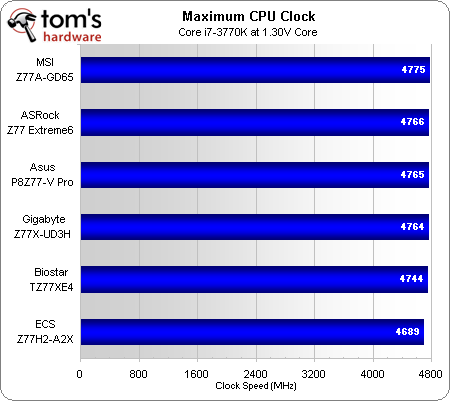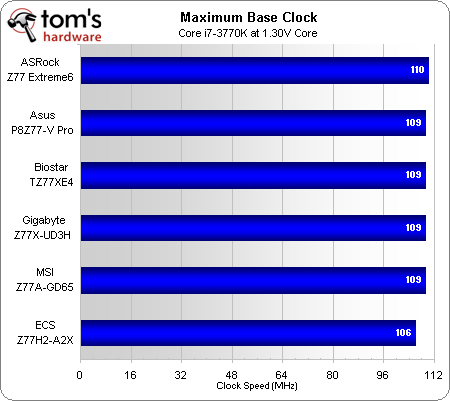Six $160-220 Z77 Motherboards, Benchmarked And Reviewed
Combining the newest features with moderate expandability, Intel’s mainstream platforms provide high value to most gaming and overclocking enthusiasts. We compare six examples with Z77 Express to find the best features, overclocking, and efficiency.
Overclocking
| BIOS Frequency and Voltage settings (for Overclocking) | |||
|---|---|---|---|
| Row 0 - Cell 0 | ASRock Z77 Extreme6 | Asus P8Z77-V Pro | Biostar TZ77XE4 |
| CPU Base Clock | 95-150 MHz (0.1 MHz) | 80-300 MHz (0.1 MHz) | 95-300 MHz (0.01 MHz) |
| CPU Multiplier | Up to 63x | Up to 63x | Up to 63x |
| DRAM Data Rates | 1066-3000 (200, 266.6 MHz) | 800-3200 (200, 266.6 MHz) | 1066-3000 (200, 266.6 MHz) |
| CPU Vcore | 0.60-2.20 V (5 mV) | 0.80-1.92 V (5 mV) | 1.00-1.79 V (10 mV) |
| VTT Voltage | 0.77-1.63 V (10 mV) | Row 5 - Cell 2 | 1.05-1.16 V (12.5 mV) |
| VCCSA Voltage | 0.93, 1.02, 1.11, 1.20 V | 0.80-1.70 V (6.25 mV) | 0.90-1.70 V (12.5 mV) |
| PCH Voltage | 0.78-1.65 V (9.3 mV) | 0.80-1.70 V (10 mV) | 1.05 V +0 to +15% (5%) |
| DRAM Voltage | 1.17-1.80 V (5 mV) | 1.20-1.92 V (5 mV) | 1.30-2.11 V (12 mV) |
| CAS Latency | 4-15 Cycles | 1-15 Cycles | 4-15 Cycles |
| tRCD | 3-15 Cycles | 1-15 Cycles | 3-15 Cycles |
| tRP | 3-15 Cycles | 1-15 Cycles | 3-15 Cycles |
| tRAS | 9-63 Cycles | 1-255 Cycles | 9-63 Cycles |
| BIOS Frequency and Voltage settings (for Overclocking) | |||
|---|---|---|---|
| Row 0 - Cell 0 | ECS Golden Z77H2-A2X | Gigabyte Z77X-UD3H | MSI Z77A-GD65 |
| CPU Base Clock | 99-150 MHz (1 MHz) | 80-300 MHz (0.01 MHz) | 0-655 MHz (0.1 MHz) |
| CPU Multiplier | Up to 59x | Up to 63x | Up to 63x |
| DRAM Data Rates | 1066-2800(200, 266.6 MHz) | 800-3200 (200, 266.6 MHz) | 800-2933 (266.6 MHz) |
| CPU Vcore | 1.00-1.50 V (15 mV) | 0.80-1.90 V (5 mV) | 0.80-2.155 V (5 mV) |
| VTT Voltage | +0 to +0.63 V (10 mV) | 0.80-1.70 V (5 mV) | 0.95-1.55 V (10 mV) |
| VCCSA Voltage | +0 to +0.63 V (10 mV) | 0.72-1.40 V (5 mV) | 0.93-1.59 V (10 mV) |
| PCH Voltage | +0 to +0.63 V (10 mV) | Not Adjustable | 0.78-1.72 V (5 mV) |
| DRAM Voltage | +0 to +0.63 V (10 mV) | 1.10-2.10 V (5 mV) | 1.11-2.46 V (7.25 mV) |
| CAS Latency | 4-15 Cycles | 5-15 Cycles | 5-15 Cycles |
| tRCD | 3-15 Cycles | 4-15 Cycles | 4-15 Cycles |
| tRP | 3-15 Cycles | 4-15 Cycles | 4-15 Cycles |
| tRAS | 9-63 Cycles | 5-63 Cycles | 10-40 Cycles |
Saving the best for last, all six of today’s motherboards yielded phenomenal air-cooled overclocking results from this specific Core i7-3770K processor. This is the first time in around two years that this editor received am above-average CPU sample on his first try, and history indicates that we’ll most likely see a greater percentage of acceptable overclocks as new steppings address minor hot spots.
MSI’s Z77A-GD65 edges out the competition for maximum CPU clock, while the second- through fourth-place overclockers are essentially tied. Biostar falls only slightly behind the median, while ECS drops a little behind Biostar.
ASRock has the highest base clock, while the top five boards prove the superiority of this specific CPU sample. Most users should expect an extra 6 MHz or so from their 100 MHz base clock, and even the bottom board gets that far.
A 2612 MT/s data rate is extremely remarkable compared to processors of old, and the fact that ASRock holds four modules stable at that setting with a $165 motherboard is similarly striking. So striking, in fact, that Asus called us out for not checking ASRock's XMP voltage more thoroughly. A retest at 1.650 V resulted in a maximum four-DIMM stable data rate of DDR3-2559 in Prime95. Two-DIMM results remained at DDR3-2700. We should also note that Asus isn't completely blameless here, as its P8Z77-V Pro showed 1.659 V in its own UEFI at the memory's XMP value of 1.650 V.
ECS sets a new standard for itself by winning the two-DIMM overclock tests, while any overclocking deficits for Biostar’s offset DIMMs appears significant only when four modules are installed.
Get Tom's Hardware's best news and in-depth reviews, straight to your inbox.
Current page: Overclocking
Prev Page Power, Heat, And Efficiency Next Page Which Mid-Range Z77 Board Should You Buy?-
yougotjaked There's a typo on the last page. It says X77H2-A2X instead of Z77H2-A2X :P It's on the second to last paragraph...Reply -
HMSvictory I am surprised that you guys did not include the Asus z77-VReply
http://www.newegg.com/Product/Product.aspx?Item=N82E16813131820 -
confish21 One thing i was looking for was the part about asrock not having true "digital" PWM and going with an analog PWM. Does this really matter?Reply -
Crashman TekN9NeGreat review! At the end of day, it comes down to brand loyalty.I don't think the article stated anything like that. It comes down to the features you want and the cards you plan to use. In the MSI vs ASRock debate, it's x8-x4-x4 with all three slots in PCIe 3.0 mode, or x8-x8-x4 with x4 in PCIe 2.0 mode, and you're definitely wiser to pick between them based on WHAT you plan to use in the third slot.simone saysdo you mean nvidia and intel gets news during weekends not only news but featured articles?It's Monday here, and editorial has very little contact with news.HMSvictoryI am surprised that you guys did not include the Asus z77-Vhttp://www.newegg.com/Product/Prod 6813131820Tom's Hardware didn't "include" anything in the review. A couple boards were excluded based on price, and everything else was let in. The P8Z77-V Pro was the cheapest board Asus sent.rickrentswhy not with Pci-e 3.0?Editor had no PCIe 3.0 cards. And the reason he didn't get one yet is because it didn't matter. The only thing that really mattered in a single-GPU MOTHERBOARD comparison was to use the same card on all platforms.confish21One thing i was looking for was the part about asrock not having true "digital" PWM and going with an analog PWM. Does this really matter?Some digital voltage regulators have been garbage, take a look at a few of the older reviews to see this. Very few have been very good. And many more analog voltage regulators have been garbage, while many more analog voltage regulators have been very good. Quality of execution is more important than the underlying technology.Reply



